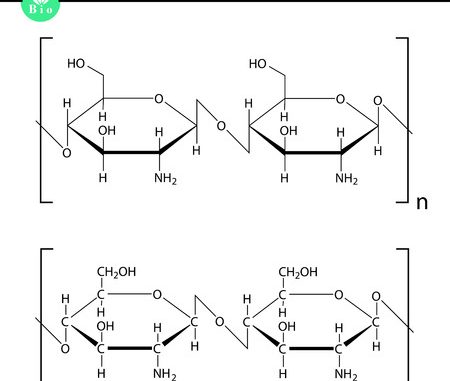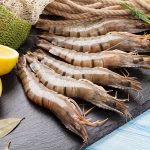
Chitosan is rapidly developing as an edible coating to protect highly perishable fruits, meats and fish.
It is a linear cationic polysaccharide composed of randomly distributed β-(1-4)-linked D-glucosamine and N-acetyl-D-glucosamine. Chitosan is derived from chitin by N-deacetylation. It is obtained mainly from the exoskeleton of crustacea such as prawns, shrimp, crab and lobster which are byproducts of the seafood processing industry and in ready supply.
Chitosan is biodegradable and has significant antimicrobial properties (Cuero, 1999; Zheng & Zhu, 2003).
Antimicrobial Properties Of Chitosan
Chitosan is thought to chelate various metal ions from the lipopolysaccharide (LPS) layer that forms the outer membrane of bacteria. It also has cross-linking activity to bacterial membranes where it exhibits electrostatic interactions between charged positive amino groups on proteins and the negative charges of the microbial cell membrane. In all cases it increases the permeability of bacterial cells especially by causing the release of cellular fragments and components.
The efficacy of chitosan as an antimicrobial depends on its molecular weight and how much polymerisation has occurred, as well as other barrier and environmental considerations that exist.
The chitosan coating acts as a barrier to oxygen transfer which inhibits the growth of aerobic bacteria (Siripatrawan and Noipha, 2012) but not anaerobic types. It also works well with the addition of other active antimicrobials such as essential oils, green tea being one example (Siripatrawan and Noipha, 2012) and with the added benefit of localising their action to the coated surface as well as helping reduce their pungent flavour.
Encapsulation Using Chitosan
Chitosan is a particularly effective material for encapsulating sensitive core ingredients, such as lipophilic drugs, vitamin D2, astaxanthin, and olive oil extract (Klaypradit and Huang, 2008).
In addition to chitosan functioning as a polymeric material and antimicrobial agent in its own right, it has been used as coating in combination with other polymers such as the protein casein for various vegetables like carrots, cheese and as a wrapper on salami (Moreira et al., 2011). One other example is as a film and coating combined with lauric arginate and nisin to reduce Listeriosis caused by L. monocytogenes population in sea foods, fish and L. innocua in sliced turkey delicatessen meat (Guo et al., 2014) and also in combination with antimicrobials or other barrier packaging with seafood and fish (Gómez-Estaca et al., 2010; Günlü and Koyan, 2013).
Chitosan also combines well with other hydrocolloids. It has been mixed with pectin for example to produce a laminated film exploiting the interactions between the cationic groups of chitosan and the anionic groups of pectin (Hoagland & Parris, 1996).
References
Cuero, R. G. (1999). Antimicrobial action of exogenous chitosan. In P. Jolle´s, & R. A. A. Muzzarelli (Eds.), Chitin and chitinases (pp. 315–333). Berlin: Birkha¨user Verlag.
Gómez-Estaca, J., López de Lacey, A., López-Caballero, M.E., Gómez-Guillén, M.C., Montero, P. (2010) Biodegradable gelatin-chitosan films incorporated with essential oils as antimicrobial agents for fish preservation. Food Microbiology, 27 (7), pp. 889–896
Günlü, A., and Koyun, E. (2013) Effects of vacuum packaging and wrapping with chitosan-based edible film on the extension of the shelf life of sea bass (Dicentrarchus labrax) fillets in cold storage (4°C). Food and Bioprocess Technology 6 (7) pp. 1713–1719
Guo, M., Jin, T.Z., Wang, L., Scullen, O.J., Sommers, C.H. (2014) Antimicrobial films and coatings for inactivation of Listeria innocua on ready-to-eat deli turkey meat. Food Control, 40, pp. 64–70
Hoagland, P., & Parris, N. (1996). Chitosan/pectin laminated films. Journal of Agriculture and Food Chemistry, 44, pp. 1915–1919
Klaypradit W, Huang Y‐W. 2008. Fish oil encapsulation with chitosan using ultrasonic atomizer. LWT 41 pp. 1133–9 (Article)
Moreira, M. D. R., Pereda, M., Marcovich, N.E., Roura, S.I. (2011) Antimicrobial effectiveness of bioactive packaging materials from edible chitosan and casein polymers: assessment on carrot, cheese, and salami. J. Food Sci., 76 (1), M54–M63
Siripatrawan, U. and Noipha, S. (2012) Active film from chitosan incorporating green tea extract for shelf life extension of pork sausages. Food Hydrocolloids, 27 (1), pp. 102–108
Xu, Y. X., Kim, K. M., Hanna, M. A., & Nag, D. (2004). Chitosan–starch composite film: Preparation and characterization. Industrial Crops and Products, 21(2), pp. 185–192
Zheng, L. Y., & Zhu, J. F. (2003). Study on antimicrobial activity of chitosan with different molecular weights. Carbohydrate Polymers, 54, pp. 527–530.

Being a vegan means I should not be eating any of this as it comes from crabs. Are there any plant sources of chitosan because it would make life a lot easier. I am basically fat so starting out on veganism will hopefully mean I lose weight but I heard that this chitosan is a weight loss product. Looking out for X-fat equivalent.